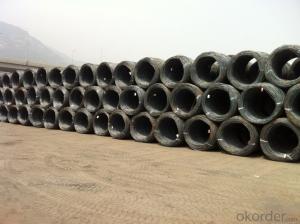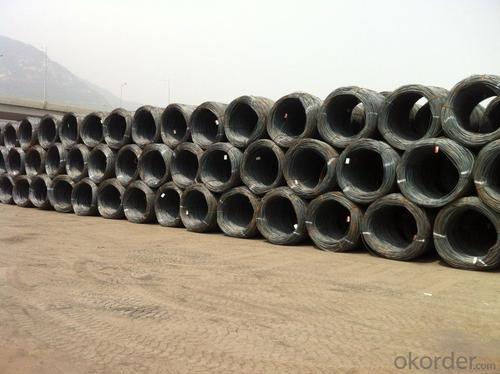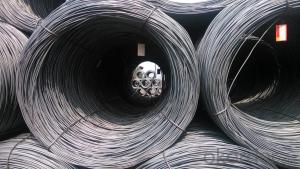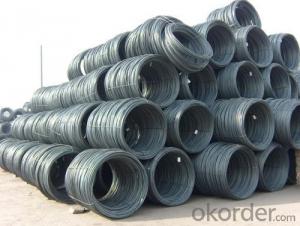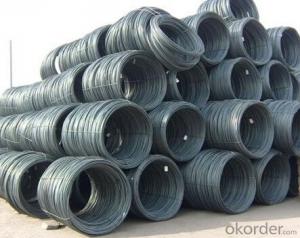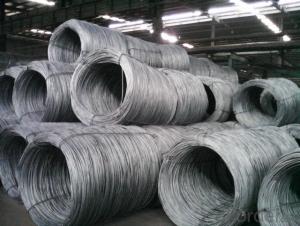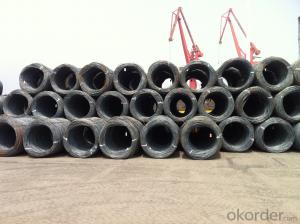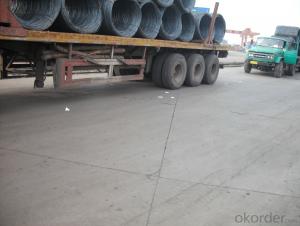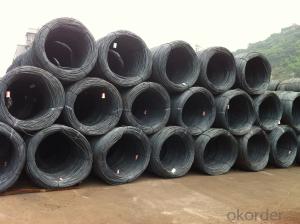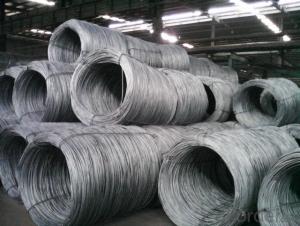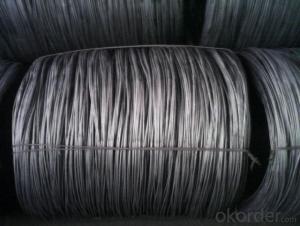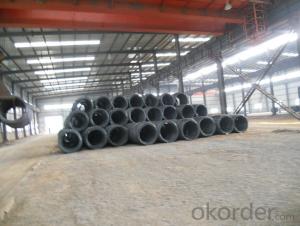Hot Rolled Wire Rods in Material Grade SAE1008
- Loading Port:
- Tianjin
- Payment Terms:
- TT OR LC
- Min Order Qty:
- 25 m.t.
- Supply Capability:
- 20000 m.t./month
OKorder Service Pledge
OKorder Financial Service
You Might Also Like
Specification
Grade: SAE1008 Standard: ASTM
Diameter: 5.5mm, 6.5mm, 7mm, 8mm, 9mm, 10mm, 11mm, 12mm
Alloy or Not: Alloy
Technique: Hot Rolled Place of Origin: China Mainland
Chemical Composition:
Please kindly find our chemistry of our material based on SAE1008 as below for your reference:
Grade | Chemical Composition (%) | |||||
C | Mn | S | P | Si | B | |
SAE1008 | 0.10max | 0.30-0.50 | 0.050max | 0.040max | 0.30max | 0.0008min |
Mechanical properties | ||||||
Yield strength(N/mm2) | Tensile strength(N/mm2) | Elongation (%) | ||||
≥195 | 350-380 | ≥32 | ||||
Usage and Applications of SAE1008 Steel Wire Rod:
After hot-rolled the products shaped into coil and delivery as finished product, including round, square,rectangular, hexagonal and so on. Since most of the products are round, it is generally called wire rod. Carbon steel wire rod is widely used in construction and manufacturing. Carbon steel wire rod is mainly used for reinforcement of reinforced concrete and welded structure or reprocessed (roberts , nail, etc.) materials, especially used to produce wire drawing, welding electrode, nails, spring, electronic, precise machinery parts and so on.
Packaging & Delivery of SAE1008 Steel Wire Rod:
Packaging Detail: products are packed in coil and then shipped by container or bulk vessel
Each coil weight: About 2.05MT
Delivery Detail: within 45 days after received deposit or LC.
Label: to be specified by customer, generally, each bundle has 1-2 labels
Trade terms: FOB, CFR, CIF
FAQ:
Q1: How soon can we receive the product after purchasement?
A1: Within three days of placing an order, we will begin production. The specific shipping date is dependent upon international and government factors, but is typically one month.
Q2: How do you guarantee the quality of our products?
A2: We have established an advanced quality management system which conducts strict quality tests at every step, from raw materials to the final product. At the same time, we provide extensive follow-up service assurances as required.
Q3: Why buy Materials & Equipment from OKorder.com?
A3: All products offered by OKorder.com are carefully selected from China's most reliable manufacturing enterprises. Through its ISO certifications, OKorder.com adheres to the highest standards and a commitment to supply chain safety and customer satisfaction.
Images of SAE1008 Steel Wire Rod
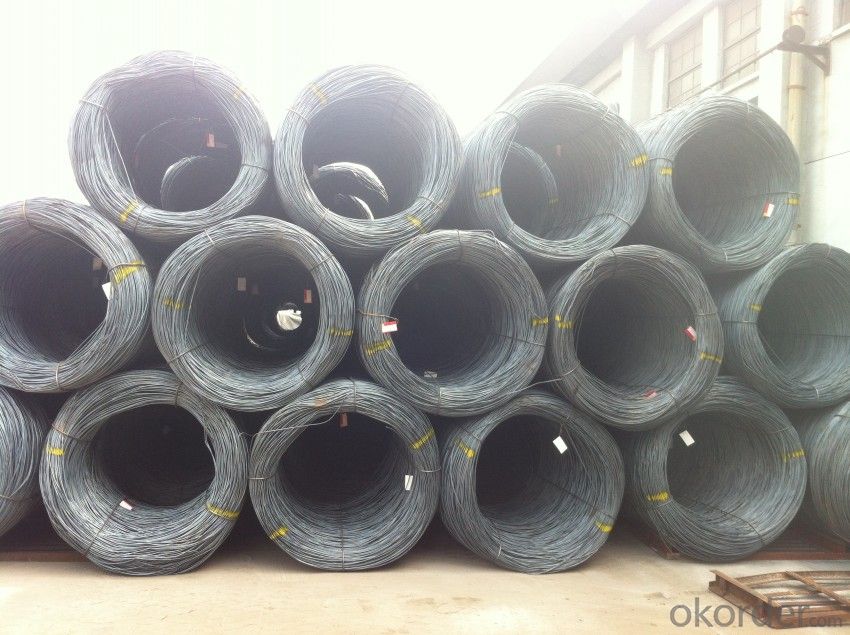
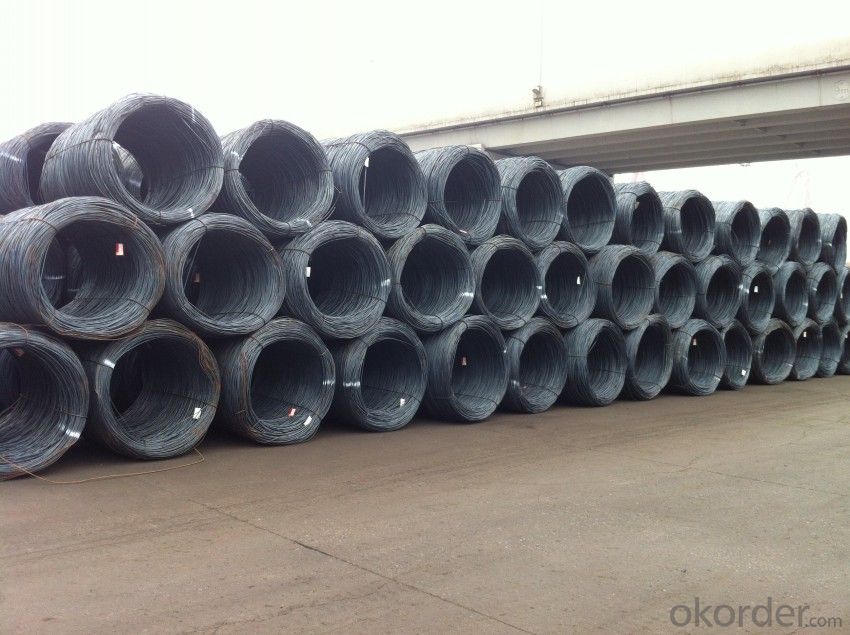
- Q: How are steel wire rods used in the production of wire coat hangers for hanging clothes?
- The durability and strength of steel wire rods make them essential for producing wire coat hangers used to hang clothes. These rods are the primary material for creating the frame and shape of the hangers. To begin, the steel wire rods are cut into the desired length for the coat hangers, ensuring the appropriate size for hanging clothes. Specialized machinery is then used to bend and shape the rods into the classic triangular form commonly associated with coat hangers. Next, the ends of the wire rods are smoothed and rounded off to prevent any sharp edges that could potentially damage clothing. This step is crucial for ensuring the safety of the hangers and avoiding harm to the garments being hung. Once the wire rods have been shaped and smoothed, they undergo a protective coating process, typically using plastic or rubber. This coating serves multiple purposes. Firstly, it prevents rusting or corrosion, ensuring the longevity of the hangers. Additionally, it provides a non-slip surface that helps prevent clothes from slipping off. Finally, the coated wire rods are securely attached to a separate hook at the top, allowing the hangers to be hung on a closet rod or any suitable hanging mechanism. This hook is usually made of either plastic or metal and ensures the stability and functionality of the coat hanger. Overall, steel wire rods are vital in the production of wire coat hangers, providing the necessary strength, durability, and shape for hanging clothes. Their versatility and ability to be shaped and coated make them an ideal material for creating reliable and long-lasting hangers.
- Q: How is steel wire rod used in the production of electrical conductors?
- Steel wire rod is a crucial component in the production of electrical conductors. It is used as a raw material to manufacture various types of wire and cables that are essential for the transmission and distribution of electricity. The process begins with the steel wire rod being drawn through a series of dies to reduce its diameter and increase its length. This drawing process not only strengthens the wire but also enhances its electrical conductivity. The resulting wire is then further processed to meet specific requirements for electrical conductors. Steel wire rod is widely used in the production of power cables, which are used to transmit electricity over long distances. These cables consist of multiple layers, including a conductor made from steel wire rod. The conductor provides a path for the electrical current to flow, enabling the transmission of power from power plants to various locations. In addition to power cables, steel wire rod is also used in the production of electrical wires and cords. These wires are used in residential, commercial, and industrial applications to connect electrical devices and appliances to power sources. Steel wire rod is chosen for its high tensile strength and durability, ensuring that the wires can withstand the demands of daily use. Furthermore, steel wire rod is used in the manufacturing of overhead transmission lines. These lines are essential for the distribution of electricity from substations to local power grids. Steel wire rod is used to create the conductive strands within these transmission lines, enabling efficient and reliable power distribution. Overall, steel wire rod plays a vital role in the production of electrical conductors. Its strength, conductivity, and versatility make it an ideal material for manufacturing power cables, electrical wires, and transmission lines. Without steel wire rod, the efficient transmission and distribution of electricity would not be possible.
- Q: How does the fatigue strength of steel wire rod vary with different heat treatment processes?
- The fatigue strength of steel wire rod can vary with different heat treatment processes. Heat treatment processes like annealing, quenching, and tempering can significantly affect the microstructure and mechanical properties of steel wire rod, including its fatigue strength. Annealing, for example, can help reduce internal stresses and improve the ductility of the wire rod, thus potentially increasing its fatigue strength. Quenching and tempering, on the other hand, can enhance the hardness and strength of the wire rod, but may also result in reduced ductility and potentially lower fatigue strength. Therefore, the specific heat treatment process used on steel wire rod can have a significant impact on its fatigue strength.
- Q: How are steel wire rods used in the manufacturing of mesh screens for filtration?
- Due to their strength, durability, and versatility, steel wire rods are vital components in the production of mesh screens used for filtration. To obtain the desired diameter and strength, these rods undergo a series of steps including heating, rolling, and cooling. Once formed, the wire rods are woven or welded together to construct the mesh screen. Mesh screens made from steel wire rods find applications in various industries for filtration purposes. In the water treatment sector, for instance, they are utilized to eliminate impurities, contaminants, and solid particles from water sources. The steel wire rods provide the necessary tensile strength and corrosion resistance, ensuring the longevity and effectiveness of the mesh screen. Customization options are available for the size and spacing of the wire rods used in manufacturing mesh screens for filtration. Different mesh sizes allow for the filtration of various particle sizes, enabling the screens to effectively capture and separate solids from liquids or gases. The steel wire rods also provide stability and structural integrity to the mesh screens, enabling them to withstand high-pressure filtration processes. To enhance their filtration capabilities, steel wire rods can be coated with different materials. For instance, a polymer coating can be applied to prevent clogging and improve the efficiency of the screen. Additionally, the mesh screens can be further processed and shaped into different forms, such as cylinders, cones, or flat sheets, depending on the design and application requirements of the filtration system. In conclusion, steel wire rods are essential in the manufacturing of mesh screens for filtration. Their strength, durability, and adaptability make them an ideal material for creating mesh screens that effectively separate and filter contaminants from various substances. This ensures the quality and purity of liquids and gases in numerous industries.
- Q: How is steel wire rod used in the construction of high-rise buildings?
- Steel wire rod is commonly used in the construction of high-rise buildings as it provides strength and durability. It is typically used as reinforcement in concrete structures, such as beams, columns, and slabs, to enhance the overall structural integrity. The wire rod is often formed into mesh or bar configurations, which are then embedded within the concrete to withstand the high loads and forces experienced by tall buildings. Additionally, steel wire rod is also utilized in the construction of pre-stressed concrete elements, which further enhances the building's strength and resistance to bending or cracking.
- Q: How is steel wire rod used in the manufacturing of wire forms for plumbing systems?
- Steel wire rod is an essential component in the manufacturing of wire forms for plumbing systems. The wire rod is made from high-quality steel, which provides the necessary strength and durability required for plumbing applications. Firstly, the steel wire rod is usually passed through a series of processes, such as heating, rolling, and drawing, to transform it into a wire of the desired diameter and shape. This wire serves as the base material for various wire forms used in plumbing systems. Once the wire is formed, it can be further processed to create different wire forms commonly used in plumbing, such as pipe hangers, brackets, clips, and supports. These wire forms are used to secure and stabilize pipes, ensuring they remain firmly in place. The use of steel wire rod in manufacturing wire forms for plumbing systems offers several advantages. Steel is known for its exceptional strength and rigidity, making it ideal for handling the weight and pressures associated with plumbing installations. Moreover, steel wire rod is resistant to corrosion, which is crucial in plumbing systems where exposure to water and moisture is inevitable. In addition to its strength and corrosion resistance, steel wire rod can be easily bent, shaped, and formed to meet the specific requirements of plumbing systems. This flexibility allows for the creation of custom wire forms that can accommodate unique plumbing layouts and configurations. Overall, steel wire rod plays a vital role in the manufacturing of wire forms for plumbing systems, providing the necessary strength, durability, and versatility required for efficient and reliable plumbing installations.
- Q: Can steel wire rod be used in the production of springs?
- Yes, steel wire rod can be used in the production of springs. Steel wire rod is commonly used due to its high strength and durability, which are essential characteristics for springs that need to withstand repeated stress and maintain their shape over time.
- Q: How is steel wire rod used in the manufacturing of wire forms for security fencing?
- The manufacturing of wire forms for security fencing relies heavily on steel wire rod. This essential component serves as the primary raw material for constructing strong and durable wire fences. To enhance its properties, such as strength, flexibility, and resistance to corrosion, steel wire rod undergoes a series of mechanical and chemical treatments. This ensures that the resulting wire forms can withstand harsh weather conditions, physical impact, and attempts at breaching. Once prepared, the steel wire rod is shaped and sized according to the specific requirements of the security fencing. This can involve creating straight wires, coils, or even intricate designs like barbed wire or razor wire, depending on the desired level of security. The wire forms are then assembled and connected to form the desired structure of the security fence. This can be achieved through techniques such as weaving, welding, or fastening with specialized tools. The strength and durability of the steel wire rod guarantee that the fence will maintain its structural integrity and resist any attempts to cut, break, or tamper with it. In addition, the steel wire rod can also be galvanized or coated with protective layers to enhance its resistance to corrosion, rust, and other environmental factors. This further extends the lifespan of the security fence and reduces the need for frequent maintenance or replacement. In conclusion, the crucial role of steel wire rod in the manufacturing of wire forms for security fencing cannot be overstated. Its strength, durability, and resistance to corrosion make it the ideal material for creating robust and long-lasting fences that provide effective security measures.
- Q: What are the main factors affecting the product quality of steel wire rod?
- The main factors affecting the product quality of steel wire rod include the chemical composition of the steel, the manufacturing process, the temperature and time of heat treatment, the mechanical properties of the steel, and the surface condition of the product. Other factors such as the raw material quality, equipment and machinery used, and the skill and expertise of the workforce also contribute to the overall product quality.
- Q: What are the different types of steel wire rod coatings available?
- There are several different types of coatings available for steel wire rods, each providing distinct properties and advantages. Some of the most common types of coatings include: 1. Galvanized Coating: This coating involves the application of a layer of zinc onto the surface of the steel wire rod. Galvanizing provides excellent corrosion resistance, making it suitable for outdoor applications and environments with high humidity or exposure to corrosive substances. 2. Phosphating Coating: Phosphating is a chemical conversion process that creates a thin layer of phosphate crystals on the surface of the steel wire rod. This coating enhances the adhesion of subsequent coatings, improves corrosion resistance, and provides a good base for painting or further treatment. 3. Polymer Coating: Polymer coatings, such as polyethylene or polypropylene, are often applied to steel wire rods to provide protection against corrosion, abrasion, and chemical exposure. These coatings offer excellent flexibility and can be customized to meet specific requirements, such as UV resistance or electrical insulation. 4. Epoxy Coating: Epoxy coatings are known for their exceptional adhesion and chemical resistance. They are commonly used in applications where the steel wire rod will be exposed to harsh chemicals, such as in the oil and gas industry or in marine environments. Epoxy coatings can also provide protection against corrosion and abrasion. 5. Zinc-Aluminum Coating: This coating, also known as Galvalume or Zincalume, involves the application of a layer of zinc-aluminum alloy onto the steel wire rod. Zinc-aluminum coatings provide excellent corrosion resistance and are often used in applications where both corrosion protection and heat resistance are required, such as in automotive or construction industries. 6. Copper Coating: Copper coatings are primarily used for their electrical conductivity properties. They are often applied to steel wire rods that will be used in electrical applications, such as wiring or cables, to enhance conductivity and reduce electrical resistance. These are just a few examples of the different types of coatings available for steel wire rods. The choice of coating depends on the specific application requirements, such as corrosion resistance, electrical conductivity, or chemical resistance, and it is essential to select the appropriate coating to ensure optimal performance and durability of the steel wire rods.
Send your message to us
Hot Rolled Wire Rods in Material Grade SAE1008
- Loading Port:
- Tianjin
- Payment Terms:
- TT OR LC
- Min Order Qty:
- 25 m.t.
- Supply Capability:
- 20000 m.t./month
OKorder Service Pledge
OKorder Financial Service
Similar products
Hot products
Hot Searches
Related keywords
